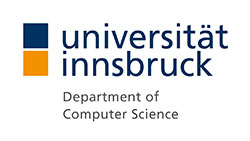Spreading excellence and disseminating the cutting edge results of our research and development efforts is crucial to our institute. Check for our educational offers for Bachelor, Master and PhD studies at the University of Innsbruck!
Improving the Usability of Social Media Management Applications
| Attachment | Size |
|---|---|
| 3.5 MB |
Abstract |
|
|
The letter press, steam engine and personal computer are some of the greatest inventions of all time. One of the more modern invention is the Internet, which transformed not only the way we communicate today but also whole business areas such as commerce, entertainment, marketing and many more. The Internet itself evolved over time in the Web 2.0 or better known under its synonym social media. It allows the creation and exchange of user generated content (UGC). One specific area of social media are social networks such as Facebook, Twitter or LinkedIn. These social networks opened the door for new ways of online marketingsocial media marketing. In order to use social networks efficiently for marketing purposes and to get closer to customers or reach potential customers, marketers rely on social media marketing software (SMMS). This kind of web-based applications support companies or individuals with publishing, engaging, promoting or listening on social media networks. In order to have a competitive SMMS, one of the most important quality factors are usability and user experience. For 48% of visitors the number one credibility factor is the design of a Web site and 38% of visitors would stop using a Web site if the layout is unattractive. Based on the use case of the social media management tool Onlim (www.onlim.com), it was explored to which extant usability tests can detect user experience issues and consequently improvements by conducting a usability lab. Often only user interface (UI) experts are used for design updates as usability tests can be time intensive and costly. Furthermore, Onlim was also benchmarked against competitor tools, mostly industry leaders, in terms of functionality and user experience in order get insights on value-adding features and usability. The thesis results of the benchmark analysis provide a clear indication that in general Onlim is behind leading industry applications such as Hootsuite and Buffer. Mainly in terms of functionality, shortcomings were identified. However, two main strengths of Onlim are the simultaneous post creation and a sophisticated RSS reader functionality. In terms of user experience, Onlim performed moderately. Furthermore, the data set of 20 participants of the conducted usability lab were used for an in-depth analysis. The analysis identified fifteen usability problems whereas five are system and ten operational problems. Overall 40% of the problems were resolved through the implementation of a new user interface design and 60% of the problems still remain in the new interface or are only partly solved. Overall the findings of the thesis can help Onlim to further improve the application, not only regarding usability but also in terms of feature extensions that were a by-product of the applied benchmark analysis. |
Contact person in charge.

